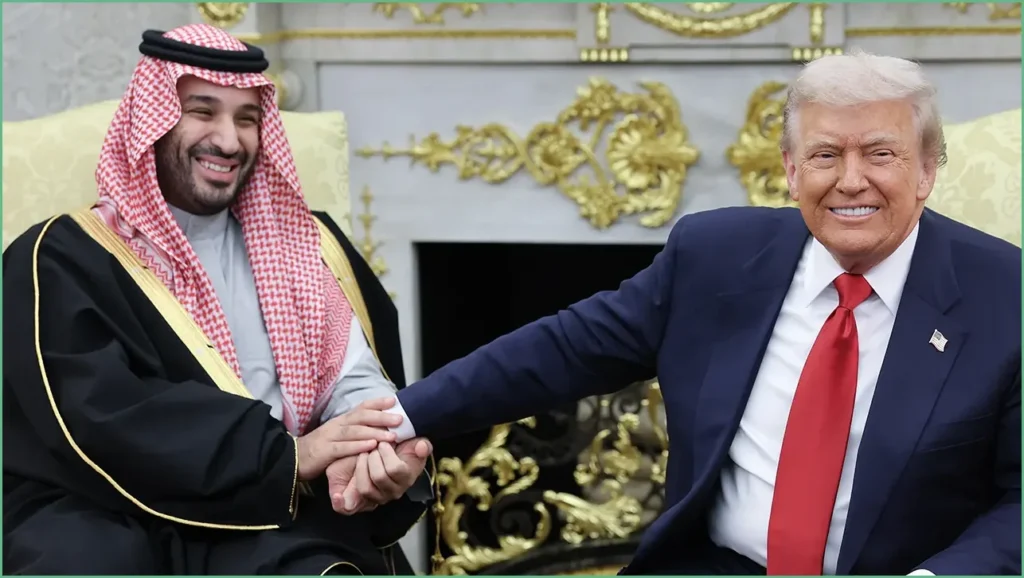President Trump’s White House meeting with Saudi Crown Prince Mohammed bin Salman announced a clear, pragmatic reset in a critical U.S.-Saudi partnership. The visit tied defense, technology and economic cooperation to broader goals: countering Iran, checking China’s influence, and accelerating American access to Saudi investment and AI collaboration. It also reopened a controversial chapter, since this was MBS’s first formal return to the White House after the 2018 Jamal Khashoggi killing, and the outcomes were decisive and forward-looking.
The long-running U.S.-Saudi relationship has survived scandals and policy drift because the strategic stakes are too high to walk away. Washington needs partners who will stand with us against Iranian proxies and push back on Beijing’s drive for influence in the region. Reuters captured the point neatly when it said U.S.-Saudi ties “endure, driven by energy, defense, [and] AI interests.”
What was striking about the meeting is how the partnership has shifted from a narrow energy focus to a multi-domain alliance built around defense, technology and mutual security goals. Saudi leaders are signaling they want American weapons, American tech and American civil nuclear cooperation while America wants a regional ally aligned against Tehran. That is the baseline of a modern strategic relationship.
SAUDI CROWN PRINCE BIN SALMAN HIKES COMMITTED US INVESTMENT TO NEARLY $1T The crown prince reaffirmed large investment commitments in U.S. AI infrastructure, critical minerals and advanced manufacturing, a move that benefits American workers and innovation. Those commitments are leverage for deeper security ties and for integrating Saudi energy and investment into Western supply chains. It’s a two-way street: we gain access to capital and markets, they get trusted technology and defense partnerships.
On weapons, President Trump was explicit and decisive, stating “I am planning on doing that… They want to buy them. They’ve been a great ally.” That promise was followed through: the administration moved to approve the first F-35 transfer to the kingdom. For Republicans who prioritize strength, restoring high-end capability to a key partner is both strategic and principled.
SAUDI FIGHTER JETS ESCORT AIR FORCE ONE AS TRUMP ARRIVES TO MEET CROWN PRINCE The optics mattered: MBS’s presence in Washington signaled that Saudi Arabia intends to play a stabilizing role in the region. Riyadh still faces hard choices on human rights and governance, but geopolitically it is positioning itself as a counterweight to Iran and as a partner against malign influence. That repositioning is important for American interests.
The meeting also pressed on the Abraham Accords question, with Trump optimistic that Riyadh could normalize with Israel “very shortly.” Progress remains conditional on steps toward Palestinian statehood, and while no final deal emerged this week, both sides reported tangible momentum. If normalization advances, it would redraw regional alignments in favor of peace and deterrence against extremist influence.
FORMER VICE PRESIDENT MIKE PENCE: FIVE YEARS ON, THE ABRAHAM ACCORDS STILL POINT THE WAY TO PEACE Saudi participation would be transformative, but it must be built on clear, verifiable steps that protect Palestinian aspirations while ensuring Israel’s security. Republicans favor arrangements that strengthen allies, expand markets, and reduce the footprint of hostile actors like Iran. Incremental progress that opens doors to deeper cooperation is the prudent path.
Beyond diplomacy, technical cooperation mattered: officials advanced discussions on a civilian nuclear framework and AI partnerships designed to secure supply chains and preserve Western tech leadership. Washington cannot cede these domains to rivals. The Atlantic Council observed Saudi Arabia as “at the forefront of a new Middle East,” and Reuters saw MBS in Washington “reclaiming the world stage,” both phrases that underscore the stakes of who leads on emerging technologies.
WHITE HOUSE THANKS UAE FOR AGREEING TO 10-YEAR, $1.4 TRILLION INVESTMENT FRAMEWORK China’s expanding footprint in the region is the clearest strategic risk, and the Trump administration’s push to anchor Riyadh in U.S. defense and tech networks responds to that threat. If the United States fails to offer credible security and technological partnership, we risk letting a China-Russia-Iran axis fill the vacuum. This reset is about making sure American power and values retain the upper hand where it matters most.
